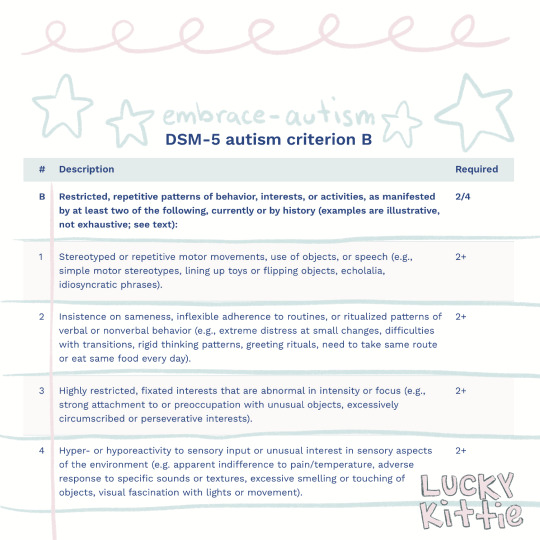#autismcriteria
Explore tagged Tumblr posts
Text
I want to begin with discussing that different countries have different processes for diagnosing Autism. It typically includes collecting information on early childhood, social understanding (both in observation and discussed experiences), sensory profiles and so on. Countries such as the US and Australia rely on the DSM-5 criteria, which is what I will be discussing today. The DSM-5 is a resource for psychologists and psychiatrists to refer to during assessment practices in any country. It states a list of criteria to receive an autism spectrum disorder diagnosis that I will share with you.



Now that we have discussed what the criteria is I wanted to discuss some comments and misinformation that has been shared online.
Firstly, autistic traits are human traits. You can be allistic (not autistic) and experience some traits of autism. For example stimming and repetitive behaviours are common in everyone for reasons such as stress, anxiety, even excitement. So this does not mean you are autistic, or “a little bit autistic”. You can be passionate about an interest and it not be a ‘special interest’ and you can have sensory sensitivities or dislike certain sensory input without being autistic. This is not gatekeeping autism. It's important to understand you have to meet the currently understood diagnostic criteria of autism to be autistic, not a little bit of it- all the indicated criteria (that in mind please remember some parts of the criteria in the dsm-5 states ‘2 of 4’ ect. And that is part of what I'm referring to).
This can translate into other countries methods and standards for diagnosing autism but it can also be important to research into the established understanding of autism in our current time. You cannot gatekeep a neurological, developmental disability and you are either autistic or you are not.
If you are reading this and are confused about what makes something an autistic trait; it is dependent on why you are experiencing this and how it impacts your day-to-day life. I can make more posts in the future about different autistic traits and how they show up but for now you can check out my posts on stimming and special interests!
I also want to make it clear that i do believe self-diagnosis is valid as it is often not an option for people to get a ‘official diagnosis’ due to its cost, family reasons and because there is still a bias in diagnosing autism for white children (mainly boys but more change is happening that includes the diagnosis of more girls). If you believe yourself to be autistic, please research as much as you can to understand yourself and learn what accommodations you can put in place to improve your day-to-day life.
I wanted to make this post and a stepping stone for undiagnosed autistic people to learn more about autism and a chance for anyone to read through the criteria if they haven't had the chance before. Learning about this criteria back when I was 15 changed my life and then I got diagnosed at 19! (that was about three years i researched and learnt about how the traits show up in my life >3< )
If anyone has any questions about this or would like to share how autism is diagnosed in their country, please feel free to comment!!
Thank you for reading!!
#actually autistic#autism#blog#writing#asd#autistic things#neurodivergent#autistic adult#neurodiversity#autistic#autismadvocate#autism spectrum disorder#autismcriteria
15 notes
·
View notes